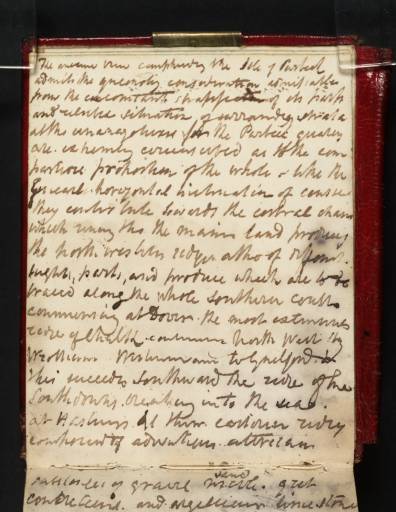Joseph Mallord William Turner Notes on the Geology of the South Coast (Inscription by Turner) c.1809-14
Joseph Mallord William Turner,
Notes on the Geology of the South Coast (Inscription by Turner)
c.1809-14
Folio 3 Verso
Notes on the Geology of the South Coast (Inscription by Turner) circa 1809–14
D07599
Turner Bequest CXI 3a
Turner Bequest CXI 3a
Pen and ink on white wove paper, 110 x 88 mm
Inscribed by Turner in ink (see main catalogue entry)
Inscribed by Turner in ink (see main catalogue entry)
Accepted by the nation as part of the Turner Bequest 1856
References
1909
A.J. Finberg, A Complete Inventory of the Drawings of the Turner Bequest, London 1909, vol.I, p.296, CXI 3a.
Turner’s inscription (not transcribed before) continues on folios 4–5 of the sketchbook (D07600–D07602) but is given in full here, as far as it can be read:
The ancient view comprehending the Isle of Purbeck | admits the ... consideration admissible | from the concomitant stratification of its parts | and relative situation of surrounding strata |, at the ... for the Purbeck quarry | all extremely circumscribed as to the comp|arative proportion of the whole . like the | general. horizontal interaction of cons ... | they contribute towards the central chasm | which running thro the main land produces | the ... although of different | heights, parts and produce which are to be | traced along the whole southern coast | commencing at Dover. the most extraneous | ridge of chalk continues North West by | ?Westerham to Guilford so | this succeeding southward the ridge of the | South Downs breaking into the sea | at Hastings As the... ridge | composed of adventitious at...[continued on folio 4, D07600] of gravel, marl [sand inserted] ... | con ... and ... limestone | ...to this follows another branch of | the main band of chalk thrusting | at bold headlong Beachey Head into | the bosom of the channel precipitous | and until a very late period had th... | ... cliffs or pinnacles calld the | ... continuing its inclined strata | it declines westward and becomes bare | recognisable in the low and ... shore | of Brighton in the sand of Worthing and | lost in the dark and oozy pool of Chichester | although skirting along the upland breaks | out on Portsmouth running its general line | is N W to Salisbury. Its next appearance | ?comprises the Western extremity of the Isle of White and by the powerful and ever dark | renovation of propelling attraction have [continued on folio 4 verso, D07601] given the Needles their characteristic name by semblance and contracted saline regulating | these Nature has thrown rather ... | line that marks the ... line but still | like the indented yet approximating headland | of the opposed coast have corresponding parts | and adopting the hyp... of Wi... or P... | ... the [?west inserted] of Britain was once cont... | by an istmus by that line of ... | Blanc ness and the depth of water ... | on the north and Westerly sides | of the Strait of Dover strengthens with the | line of adventitious stones of all sorts | calld boulders form a line of 10 miles | although 20 fathoms on each side con... | the con... almost beyond plausibility | that the waters from the overwhelming ocean | to the north abounds the accumulation by the [continued on folio 5, D07602] the circumference meeting always at | the point of ... and Fairlight | near Hastings at least strengthens the sand | ... might upon the same basis of | circumference have produced the tonge | formed from a coast of sand and mud | the istmus near Lymington con | tracts... the channel of the Island to | a mile as well in north shallow | at south deep water. this likewise may | be constant ... wholly accumulating of | surrounding stratification but while there | are wr. to trace the rocky co... of | of marl sand retrenching strata of | Alum bay or the projecting insolated | and abrupt Needles
Turner read books on regional geology while preparing for illustrations for George and William Bernard Cooke’s Picturesque Views on the Southern Coast of England published 1814–26. He also drafted a poem to accompany the plates,1 which may explain some of the more colourful language here. These notes are probably culled from various sources and have not been traced to a single publication. The phrasing is characteristically Turner’s.
David Blayney Brown
May 2011
See notes to the Devonshire Coast No.1 sketchbook (Tate D08362–D08806; D40902–D40906; D41520–D41521; Turner Beq uest CXXIII).
How to cite
David Blayney Brown, ‘Notes on the Geology of the South Coast (Inscription by Turner) c.1809–14’, catalogue entry, May 2011, in David Blayney Brown (ed.), J.M.W. Turner: Sketchbooks, Drawings and Watercolours, Tate Research Publication, December 2012, https://www

